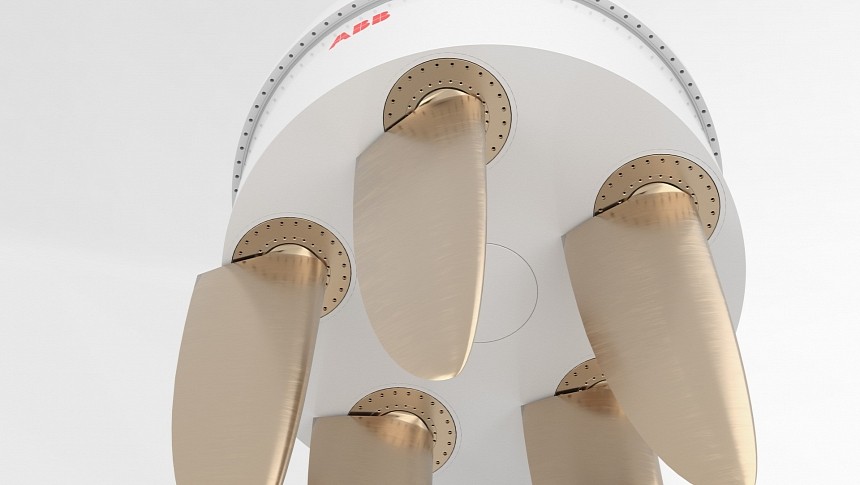IMO (the International Maritime Organization) wants to cut greenhouse gas emissions by half by 2050, compared to 2008. That's no easy task, considering maritime transportation, like aviation, is notoriously difficult to decarbonize. Efficient electric alternatives could be part of the solution, as this revolutionary propulsion concept aims to prove.
Certain bird species have proven invaluable sources of inspiration for aerodynamic designs in aviation. Sea creatures could provide the same benefit to a new generation of emission-free propulsion systems in the maritime industry. Technology expert ABB has unveiled a concept called ABB Dynafin, claiming to be revolutionary in terms of energy savings.
Part of what makes the ABB Dynafin so efficient is the unique design derived from the specific way in which whales use their tails to move. It's comprised of an electric motor and a large wheel with vertical blades extending from it. The main motor powers the wheel, and each blade is activated by an individual motor and dedicated control system.
This combination results in a double movement - propulsion and steering force at the same time, thanks to the wheel rotating at 30 to 80 rounds per minute, together with the moving blades. According to ABB, this leads to unprecedented efficiency and precision for vessels.
The ABB Dynafin proved to deliver 22% energy consumption savings related to propulsion, in contrast with current shaft line configurations. This was the result of an independent test where different types of propulsion systems were added to a passenger ship design.
At first, the ABB Dynafin solution will be available in a power range of 1 to 4 MW per propulsor, with configurations starting at two units per ship. One of the system's main advantages is its high flexibility.
It works just as well with new builds as with existing vessels (as a retrofit solution), and it can be integrated into anything from passenger and vehicle ferries to yachts and support vessels in the offshore energy sector. Although there's no limit on how many units can be integrated on a single ship, the ABB Dynafin is mainly recommended for small to medium-sized ships.
When it comes to yachts and passenger ferries, it also adds the important benefit of lower noise and vibration levels for a more comfortable experience on board.
In the future, this whale-inspired propulsion concept could bring emission levels to zero if it's integrated into a battery-electric system or a hydrogen-electric alternative based on fuel cell technology. Perhaps a future where commercial ships and pleasure craft can take full advantage of electric propulsion is not that far.
The maritime technology expert plans to officially launch the ABB Dynafin two years from now and hopefully pave the way for clean maritime operations that don't sacrifice efficiency.
Part of what makes the ABB Dynafin so efficient is the unique design derived from the specific way in which whales use their tails to move. It's comprised of an electric motor and a large wheel with vertical blades extending from it. The main motor powers the wheel, and each blade is activated by an individual motor and dedicated control system.
This combination results in a double movement - propulsion and steering force at the same time, thanks to the wheel rotating at 30 to 80 rounds per minute, together with the moving blades. According to ABB, this leads to unprecedented efficiency and precision for vessels.
The ABB Dynafin proved to deliver 22% energy consumption savings related to propulsion, in contrast with current shaft line configurations. This was the result of an independent test where different types of propulsion systems were added to a passenger ship design.
At first, the ABB Dynafin solution will be available in a power range of 1 to 4 MW per propulsor, with configurations starting at two units per ship. One of the system's main advantages is its high flexibility.
It works just as well with new builds as with existing vessels (as a retrofit solution), and it can be integrated into anything from passenger and vehicle ferries to yachts and support vessels in the offshore energy sector. Although there's no limit on how many units can be integrated on a single ship, the ABB Dynafin is mainly recommended for small to medium-sized ships.
When it comes to yachts and passenger ferries, it also adds the important benefit of lower noise and vibration levels for a more comfortable experience on board.
In the future, this whale-inspired propulsion concept could bring emission levels to zero if it's integrated into a battery-electric system or a hydrogen-electric alternative based on fuel cell technology. Perhaps a future where commercial ships and pleasure craft can take full advantage of electric propulsion is not that far.
The maritime technology expert plans to officially launch the ABB Dynafin two years from now and hopefully pave the way for clean maritime operations that don't sacrifice efficiency.








